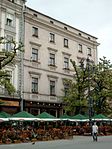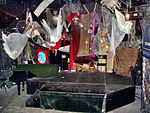Kraków Society of Friends of Fine Arts
Art Nouveau architecture in PolandCulture in KrakówPolish artPolish culture

The Kraków Society of Friends of Fine Arts (Polish: Towarzystwo Przyjaciół Sztuk Pięknych w Krakowie, TPSP) is a social group of artists, artisans and their supporters founded in Kraków in 1854, under the Austrian Partition of Poland. Today, the Society operates from the Art Nouveau Palace of Art erected by its own members in 1901 at the Szczepański Square in Kraków Old Town. After major renovations of the Palace in 1996, the Society organizes local and international art exhibits and numerous other art initiatives.
Excerpt from the Wikipedia article Kraków Society of Friends of Fine Arts (License: CC BY-SA 3.0, Authors, Images).Kraków Society of Friends of Fine Arts
Plac Szczepański, Krakow Stare Miasto (Old Town)
Geographical coordinates (GPS) Address Nearby Places Show on map
Geographical coordinates (GPS)
| Latitude | Longitude |
|---|---|
| N 50.064 ° | E 19.9349 ° |
Address
Pałac Sztuki
Plac Szczepański 4
31-011 Krakow, Stare Miasto (Old Town)
Lesser Poland Voivodeship, Poland
Open on Google Maps









